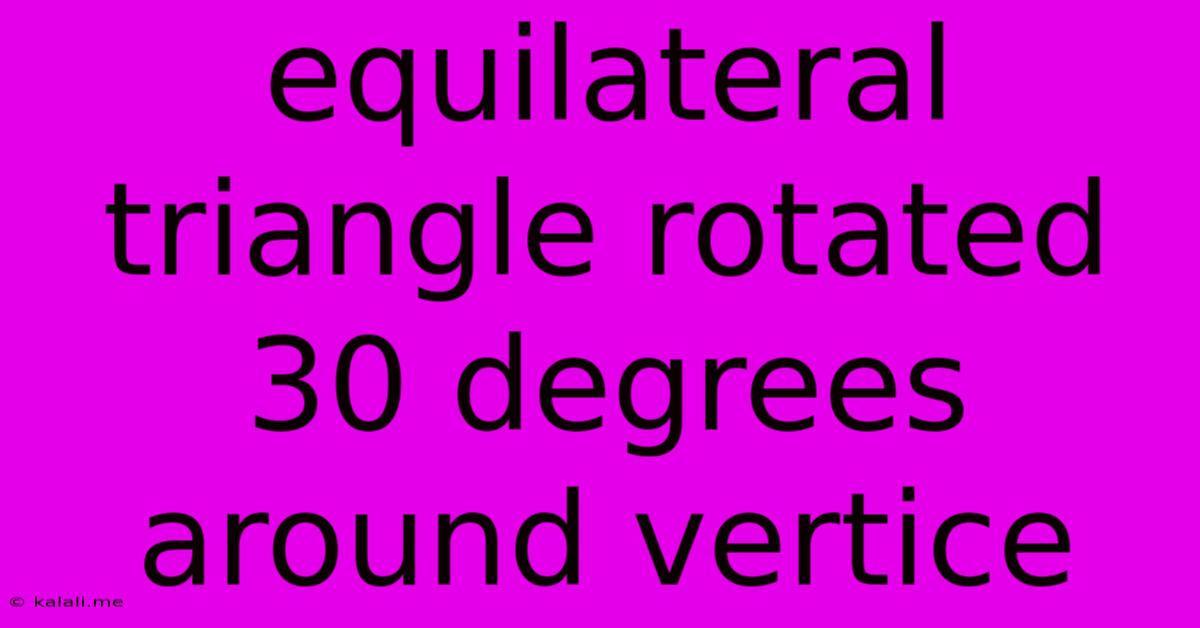Equilateral Triangle Rotated 30 Degrees Around Vertice
Kalali
May 23, 2025 · 3 min read

Table of Contents
Exploring the Geometry of an Equilateral Triangle Rotated 30 Degrees
This article delves into the fascinating geometric transformation that occurs when an equilateral triangle is rotated 30 degrees around one of its vertices. We'll explore the resulting shape, its properties, and the implications of this rotation. Understanding this seemingly simple transformation offers insights into rotational symmetry and more complex geometric concepts.
What Happens When You Rotate an Equilateral Triangle?
An equilateral triangle, by definition, possesses three equal sides and three equal angles (each measuring 60 degrees). Its inherent symmetry is a key characteristic. When we rotate this triangle 30 degrees about a vertex, we create a new configuration while preserving certain key properties. The rotation maintains the equilateral nature of the triangle itself; it simply changes its orientation in space.
The 30-Degree Rotation: A Detailed Look
Imagine an equilateral triangle ABC. Let's rotate the triangle 30 degrees clockwise around vertex A. What happens?
- Vertex A remains fixed: The point of rotation remains unchanged.
- Vertices B and C move: Vertices B and C trace out arcs of circles with A as the center. The radius of these arcs is the length of the sides of the triangle.
- New positions: B and C will occupy new positions, let's call them B' and C', respectively. The triangle AB'C' is still an equilateral triangle, congruent to triangle ABC.
Key Properties After Rotation:
- Congruence: The rotated triangle (AB'C') is congruent to the original triangle (ABC). This means that all corresponding sides and angles are equal. This congruence is a direct consequence of the rotational symmetry of the equilateral triangle.
- Symmetry: While the orientation changes, the rotational symmetry of the equilateral triangle is preserved. It still possesses 120-degree rotational symmetry around its centroid (geometric center).
- Relationship between triangles ABC and AB'C': The triangles share a common vertex (A) and two sides of equal length. The angle between these two sides is 30 degrees different.
Applications and Further Exploration:
Understanding the effects of rotating an equilateral triangle (and other shapes) has practical applications in several fields:
- Computer Graphics: Rotation is a fundamental transformation in computer graphics, used to create animations and manipulate 3D models.
- Crystallography: The symmetry properties of shapes like equilateral triangles are crucial in understanding the structure of crystals.
- Engineering: Rotational symmetry influences design considerations in various engineering disciplines.
This exploration of the 30-degree rotation of an equilateral triangle opens up possibilities for deeper investigations. You could explore:
- Rotations around other vertices: What happens if you rotate around B or C?
- Different rotation angles: Explore the results of rotations of 60, 90, or other angles.
- Other shapes: Apply similar rotational transformations to squares, pentagons, and other polygons.
By understanding the simple transformation of rotating an equilateral triangle, we gain a more profound appreciation for geometric concepts like rotational symmetry, congruence, and the power of geometric transformations in various fields. This seemingly basic exercise provides a strong foundation for understanding more complex geometric problems.
Latest Posts
Latest Posts
-
Hash Of Data Does Not Match Digest In Descriptor
May 24, 2025
-
How To Tell If Avocado Is Bad
May 24, 2025
-
F 14 Fighter Jet For Sale
May 24, 2025
-
Do Christians Believe In The Virgin Mary
May 24, 2025
-
Mtg Play Card When You Search
May 24, 2025
Related Post
Thank you for visiting our website which covers about Equilateral Triangle Rotated 30 Degrees Around Vertice . We hope the information provided has been useful to you. Feel free to contact us if you have any questions or need further assistance. See you next time and don't miss to bookmark.